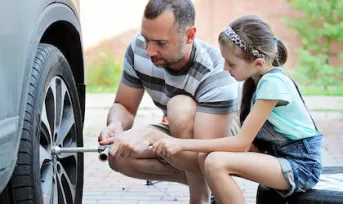
The Benefits of Living Green: 6 Ways To Start Today
Living a sustainable lifestyle doesn't have to be expensive. In fact, incorporating eco-friendly practices into your life can save you money in the long run.
Here are some budget-friendly ways to start living green today.
Benefits of living green
Green living means making eco-friendly decisions about energy, waste, transportation, and product consumption to reduce your impact on the environment. Not only is it better for the planet, but it can also lead to a healthier and more purposeful way of living.
Going green doesn’t necessarily mean overspending on personal products, cleaning supplies, and sustainably sourced materials. In fact, with a little effort, you can live green and spend the same amount you currently do — or even less!
Saves money
You might experience “sticker shock” when looking for ways to live green.
For example, an incandescent light bulb costs about a dollar, but the same wattage LED bulb can cost up to four bucks. Those incandescent light bulbs seem more cost-effective until you look at the hours you get from each bulb. That $1 bulb provides around 1,200 hours of use, but the $4 bulb offers about 25,000 hours (approximately 9.7 years!). You’d have to buy 21 incandescent bulbs ($21) to get the same hours as one LED bulb ($4).
By adopting a “long-term returns” mindset, you can justify the higher initial costs of energy-efficient and eco-friendly items.
Living green might take more effort, but it pays off in the long run.
>Related: 6 Money Challenges To Try Today
Reduces waste
Green living can reduce or eliminate waste in different ways. You can buy products with minimal or recyclable packaging, use household organic waste for compost, repurpose items instead of throwing them out, and recycle. These intentional practices keep excess trash out of landfills. You’ll also conserve natural resources and reduce the pollution produced by waste disposal.
Creates a healthier environment
Green living doesn’t just mean a healthier outdoors; it also creates healthier indoor environments. Many products we bring into our homes contain toxic ingredients or volatile organic compounds (VOCs). Paint is a prime example of a product that releases VOCs over time. If you accumulate enough unhealthy products in your home, the lower air quality can affect your respiratory system and general health.
Replacing conventional products with eco-friendly toiletries, cleaning supplies, fabrics, formaldehyde-free furniture, and low-VOC paint can significantly improve your home’s health. If you're overwhelmed with these changes, consider low-cost houseplants to remove airborne toxins and improve indoor air quality.
Reduces your carbon footprint
A carbon footprint is the total carbon dioxide and other greenhouse gas emissions an individual, product, activity, or entity generates. Reversing the effects of climate change requires finding ways to reduce carbon footprints. Conserving energy, using renewable energy, and reducing dependence on fossil fuels are all ways to reduce our carbon footprint.
So, what can you personally do? Look for ways to lower your utility usage. If you own your home, consider solar energy programs for homeowners. Drive fewer days each week. Reduce household waste. Starting small is starting somewhere!
6 low-cost ideas to go green
There are many ways you can start living green without blowing your budget.
1. Meal prep
Meal planning instantly freed up money in my food budget. Knowing what I need to buy makes shopping intentional and strategic. I plan meals around meat sales, buy certain items in bulk, select the “un-prepped” versions of produce I can prep myself, and opt for generic or store brands when possible.
When cooking for my significant other and myself, I aim to prepare meals that will feed us for at least two nights. We also keep ingredients on hand for our favorite quick meals to eliminate weeknight takeout. My favorite game-changer has been dividing a large casserole into two smaller ones and freezing the second half for later. No more “leftovers burnout” because we’re on Day 4 of the same casserole!
Before we planned our meals like this, we habitually exceeded our food budget. Now we usually have $50-$100 to roll over to the next month, and we hardly ever throw out food.
>Related: Tips to Eating Healthy On a Budget
2. Thrift shop and upcycle
I wish I’d discovered secondhand stores sooner! I’ve bought clothing, luggage, kitchenware, linens, and furniture from thrift stores and have been thrilled with the quality and prices.
Some secondhand stores offer a “color of the day” for 50% off the marked prices. On my last trip, I scored a $7 cookbook for $3.50 at checkout (less than online used-book prices).
And who doesn’t love freebies? We sourced around 75% of the furniture in our apartment from friends, community swaps, and other places around our city. Once, I even found the jade plant I’ve always wanted in our community swap room!
3. Recycle
If recycling is part of your waste management service, it’s one of the simplest green living habits to start. Designate containers for recyclables and build a habit of separating them from household garbage as soon as they’re ready to be discarded. For example, we have a bag in our kitchen that my husband puts his rinsed V8 cans in.
If you have space, set up totes as a recycling station to break down boxes, sort plastic and glass, and save newspapers. Then, you can easily transport them to curbside recycling containers.
Repurposing is another option for some items. I’ve cleaned old candle jars for holding Q-tips or cotton balls, used jelly jars to propagate plants, and saved up newspapers for papier-mâché crafts.
4. Drive less
Not everyone can access a robust public transportation system, bike or carpool to work, or work remotely. But, if you have the option, consider leaving your car parked at home more often.
By not driving daily, you’ll reduce carbon emissions, be one less car on the road, and save on fuel and maintenance costs.
Living in Portland, I know firsthand that public transportation is a vast money-saver compared to weekly gas costs for commuting and running errands. Sure, errands take longer with public transportation, but we love the money we save — and we use rides to read, catch up on social media, or relax and enjoy the scenery.
5. DIY personal and cleaning products
If you’re crafty, make your own natural soaps! Most ingredients are biodegradable, and you can customize the soaps to your liking. Beyond hand and bath soaps, you can even make solid dish soap bars, which are more concentrated than liquid soap.
Want to ditch chemical-laden cleaning products? Make your own with vinegar, water, and essential oils. You might even mix your own natural laundry detergent using baking soda, washing soda, and castile soap.
6. Grow your own produce
Food costs have increased significantly, and fresh produce is no exception. If you have an outdoor space, consider growing herbs and veggies. Even if all you have is a balcony, you’ve got space for a container garden.
For example, you can use stakes and trellises to grow tomatoes, cucumbers, peppers, squash, or beans vertically. Some tomato varieties will even grow in hanging planters.
If you don’t have a balcony (like me), it’s easy to grow your own herb garden in pots on a sunny windowsill. Growing your own produce saves money and reduces the carbon footprint of commercial food production and transportation. You can also grow your food organically without paying organic prices at the grocery store.
Saving money while saving the planet
A green lifestyle doesn’t mean changing everything you do overnight or blowing your budget on expensive products. You can start by adopting small practices that fit your life — and some may not cost a penny. Making time for intentional planning and eco-friendly decisions can add up to big savings while making you feel good about reducing your impact on the environment.
Notice: Information provided in this article is for informational purposes only. Consult your attorney or financial advisor about your financial circumstances.


